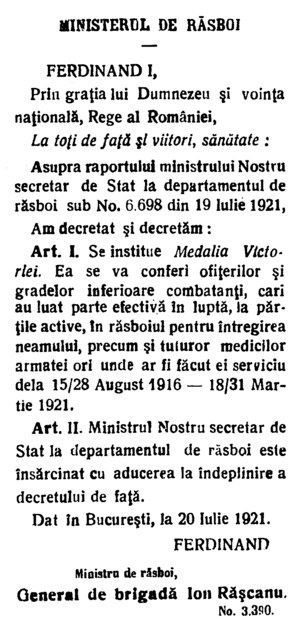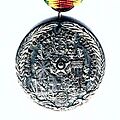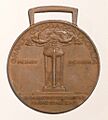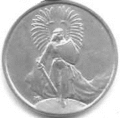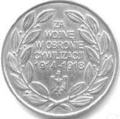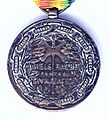Victory Medal (Romania) facts for kids
Quick facts for kids Victory Medal |
|
|---|---|
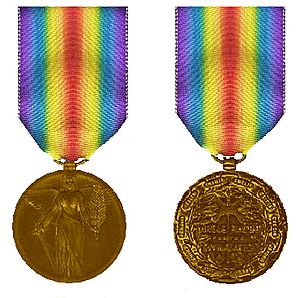
Obverse (left) and reverse (right) of the medal
|
|
| Type | Campaign medal |
| Eligibility | Romanian Army |
| Awarded for | Campaign service |
| Campaign(s) | First World War, Hungarian–Romanian War |
| Description | Bronze disk, 36mm diameter |
| Clasps | None |
| Statistics | |
| Established | 20 July 1921 |
| Precedence | |
| Next (higher) | Commemorative Cross of the 1916–1918 War |
Ribbon bar |
|
The Victory Medal is a special award from Romania given to soldiers who served in the First World War. It was created on July 20, 1921, by a royal order. This medal honored those who fought for their country during a very important time in history.
Many other countries that fought together in the war also created their own versions of this medal. These included Belgium, Brazil, France, the United States, and more. Most of these medals featured a 'Winged Victory' design, like the ancient Greek goddess Nike. Each country made its medal a bit unique.
Contents
Who Earned the Victory Medal?
To earn the Victory Medal, soldiers of any rank needed to have joined the war effort. They also had to have fought in a battle between August 28, 1916, and March 31, 1921. Army medics who served during this time could also receive the medal. This included soldiers who fought in the Hungarian–Romanian War.
What Does the Medal Look Like?
The Romanian Victory Medal is a round bronze medal, about 36 millimeters wide. A special international group chose its design. A Romanian officer named Constantin Kristescu created the winning design. The medals were made in Paris, France.
Front of the Medal
The front of the medal shows a figure of 'Victory' with wings. She stands tall and holds a palm branch in her left hand. In her right hand, she holds a sword pointing downwards. This design represents triumph and peace after the war.
Back of the Medal
The back of the medal has the words "MARELE RĂZBOI / PENTRU / CIVILIZAȚIE." This means "The Great War / For / Civilization." These words are placed over a halberd, which is a type of old weapon. A wreath made of laurel and oak leaves surrounds the words.
Around the edge, there are twenty links. On ten of the larger links, the names of the Allied countries are carved. These countries are England, Belgium, Greece, Japan, Serbia, United States, China, Romania, Italy, and France. The artist, Kristescu, signed his name near Japan's link.
The Ribbon
The medal hangs from a colorful ribbon that is about 39 millimeters wide. The ribbon has a special shimmering look. Its colors change from violet on the edges to a central red stripe where they meet. This rainbow-like design was common for many of the Victory Medals.
How the Medal Was Worn
Soldiers wore the Victory Medal on the left side of their jacket during official events. For less formal occasions, they would often wear only a small ribbon bar. This bar was pinned to the left buttonhole of their clothing. The Victory Medal was an important symbol of service in the First World War.
Other Countries' Victory Medals
Many other countries that fought in the First World War also created their own Victory Medals. This idea came from French Marshal Ferdinand Foch, who was a top commander for the Allied forces. Each of these medals was made of bronze and was 36 millimeters wide. They all had the same rainbow-colored ribbon.
Most of these medals featured a 'winged victory' design, just like Romania's. However, Japan and Siam (now Thailand) used different designs. This was because the idea of a winged victory did not fit their culture.
Images for kids
See also
- Order of Michael the Brave
- Commemorative Cross of the 1916–1918 War


